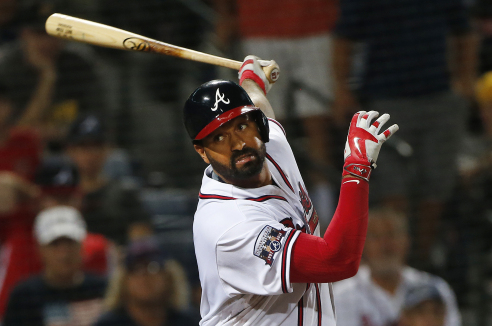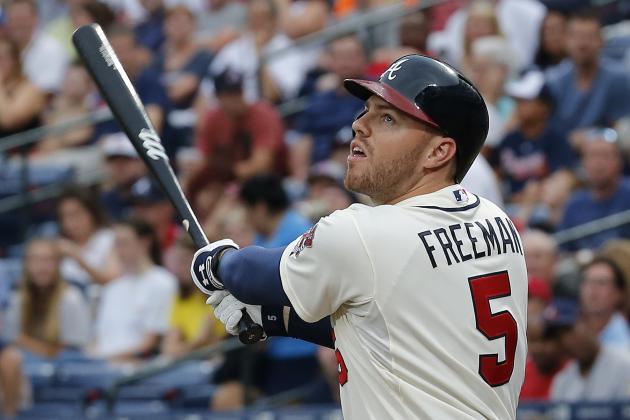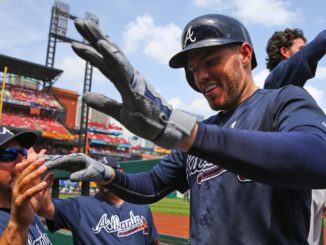Lineup protection is something that’s still discussed pretty heavily in baseball these days. While many saber-concepts have caught on with the mainstream, like shifting defenses, eliminating sacrifice bunts, the silliness of pitcher wins, and better usage of elite relievers, lineup protection doesn’t really get questioned as much. In 2016, Atlanta gave us an interesting scenario in which to take a look at lineup protection on the micro level. On July 30, Atlanta traded Hector Olivera to San Diego for Matt Kemp and cash. After a two-month surge offensively, many Braves fans are now speculating that Kemp was the answer to the offensive problems, not just for his spot in the lineup, but for the batters he affected around him.
First off, Kemp was excellent offensively in Atlanta, slashing .280/.336/.519 with 12 HR in 241 plate appearances. His presence certainly made the offense better. Through July 30, Atlanta hit .242/.305/.356. After Kemp’s arrival, the team hit .278/.348/.436. Correlation doesn’t always equate to causation, though. Teammates might have just managed to hit better on their own, something that may have happened without Kemp on the roster. All that is hard to tell. Then again, Matt Kemp may have worked with teammates on things. Perhaps he’s a hitting coach in the field, a former MVP-level player with a decade of intel that he shares effectively with his teammates. I’m not discounting that possibility at all.
The only question I’m trying to answer is this one – did Kemp help the hitter in front of him see better pitches to hit? That’s the conventional wisdom, of course. Conventional wisdom dictates that a player will perform better with “protection” batting behind him. The idea is that to avoid having to face the next guy with a player on base, more strikes will be thrown to the guy hitting in front. If all that seems a little counter-intuitive, it is, and just a tiny bit of scrutiny makes it a bit of a head-scratcher. Let’s say player A is a good hitter who bats 3rd. Player B is a good hitter who bats 4th. Let’s follow the logic:
- Pitcher sees Player B on the on-deck circle, thinks “I don’t want him batting with Player A on base”
- Pitcher throws Player A more hittable pitches to avoid a walk
- Player A is then more likely to get on base
Mission accomplished? Maybe I’m being a bit harsh, because there is some basic logic to it. If I were batting behind Freddie Freeman, he would indeed get walked unanimously, because there would be little to no chance of me advancing him. There would also be little to no chance of me not flailing out of the batter’s box on every single pitch, shrieking loudly, as I’ve never dug in against 96 mph heaters and don’t really want to, but I digress. However, Freeman isn’t followed by me. He’s followed by major league hitters. Some are really good major league hitters and others are not really good major league hitters, but they’re all major league hitters. Good ones will get a hit 29% of the time, compared to the bad ones getting a hit 23% of the time. That’s not a huge gap. It’s a measurable one that makes the 29% guy more valuable over long stretches of time, but in a single inning, in a single moment, it’s not a big difference.
Kemp debuted on August 2, and almost exclusively batted behind Freeman in the lineup. Only 4 games over the rest of the season had lineups without Freeman/Kemp at #3/#4 in the order, and all involved days of rest for either. If Kemp protected and boosted the potential of any player, it would have been Freeman.
Freddie Freeman had a pretty special year in 2016, finishing tops in fWAR among major league first basemen. Move over Rizzo & Goldschmidt! He batted .302/.400/.569 (there’s nothing prettier on a stat sheet than a .300/.400/.500 line) with career highs in runs (102), hits (178), doubles (43), triples (6), home runs (34), stolen bases (6), hit by pitch (10), and intentional walks (18). Pretty, pretty, pretty good. At the time of the Kemp trade, his numbers weren’t quite at that level, though, as he was slashing .286/.370/.519 on July 30. Still good, but not as good. Before we give Kemp too much credit for Freeman’s explosion, let’s note that the first baseman had a pretty awful slump to start the season. Over his first 18 games, Freeman slashed .177/.311/.258. From April 25-July 30 (post slump, pre-Kemp), Freeman was around his season average, hitting .307/.382/.568. After Kemp’s acquisition, Freeman was incredibly good: .333/.453/.667. That’s Albert Pujols in his MVP years kind of stuff. That’s peak Manny Ramirez. It was only two months, but it was crazy-good.
Kemp may not inspire as much fear as he did 5 years ago, but he’s been an above-average hitter more often than not, and he was having a pretty good 2016 when he came to Atlanta. He’s still worth fearing a bit, and compared to Nick Markakis and other “protectors” prior to his arrival, he was considerably more fearsome. So, how much of Freddie’s offensive explosion was Freeman just hitting the next level, and how much was the result of pitchers throwing him more to hit because of Kemp-fear?

Using data found at the excellent texasleaguers.com (bookmark it, play around, etc), here’s what we see – all percentages represent a percentage of total pitches:
| time | fastballs | fb in zone |
|---|---|---|
| through 7/30 | 57.8% | 38.5% |
| after 7/30 | 57.6% | 34.7% |
I have to admit, I didn’t expect to see that. I thought, perhaps, that we’d see a slight uptick in fastballs in the zone, but nothing significant. Instead, it was a noticeable drop. Freddie Freeman saw fewer fastballs in the zone with Matt Kemp in the lineup than he did before Kemp’s arrival.
If he was seeing fewer fastballs in the zone, maybe he saw an uptick in other hittable pitches? Sliders?
| time | sliders | sliders in zone |
|---|---|---|
| through 7/30 | 19.3% | 11.7% |
| after 7/30 | 20.4% | 11.9% |
He saw a few more hittable sliders after Kemp arrived, but too few to really notice. How about changeups?
| time | changeups | changeups in zone |
|---|---|---|
| through 7/30 | 11.3% | 6.0% |
| after 7/30 | 12.0% | 6.0% |
Not that either.
Overall, 62.2% of pitches Freeman saw before Kemp’s arrival were in the strike zone. After Kemp arrived, it was 58.7%. If Freeman got any protection from Kemp, it was psychological. Maybe Freeman better approached pitchers with confidence that if he couldn’t get the job done, another run producer might. Maybe Kemp directly helped Freeman prepare. Maybe tips were shared and something did indeed change thanks to Kemp’s presence.
One thing is for sure, however: Freddie Freeman didn’t start seeing more hittable pitches when Matt Kemp arrived in Atlanta. He saw fewer. That may be because Freeman himself started scaring pitchers far more than he did before, or it could be that pitchers worked harder to retire Freeman to avoid facing Kemp with runners on. Or it could just be random deviation. The point is, one of the frequently held benefits of lineup protection – seeing more pitches in the zone – wasn’t only untrue for Freeman & Kemp, but it was opposite of what actually happened. There’s some evidence out there that lineup protection is more of a theoretical concept that doesn’t play out in reality. Regardless of how you feel about that, we can say that Kemp’s presence in the lineup didn’t have the effect on Freddie Freeman that you’d have expected, were you one to buy into the theory of protection.
The takeaway here is this – Freddie Freeman seemed to turn a corner in 2016, becoming an elite hitter. After delving into how pitchers approached him, this improvement from Freeman seems to have more to do with Freeman himself than who was or wasn’t batting after him in the order. That’s a very good thing for Atlanta, who has Freeman under contract for the next 5 years at $106.5M. If his late 2016 improvements stick, that will be one hell of a bargain.





One thing I don’t often see as a contribution to Freeman’s late-season surge is health. From mid-June through mid-July he was playing through a cracked rib that he hid from the public, and kept him from taking any batting practice for at least a two-week span. I don’t think it should be surprising that his numbers saw an uptick after those ribs healed.
Absolutely. Also, early in the year, there still could have been residual pain, discomfort, or timing issues from last season’s wrist injury.
I think the 2nd half will see some regression in 2017 due to a fairly higher than normal (both for him and the league) HR/FB rate, but he should still be an MVP caliber performer.